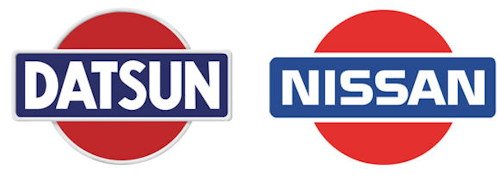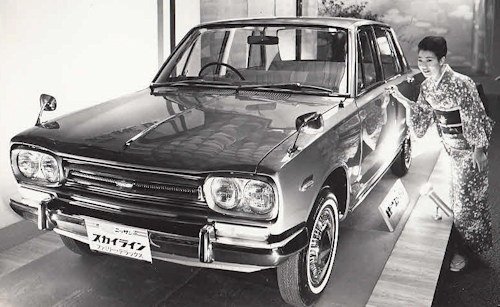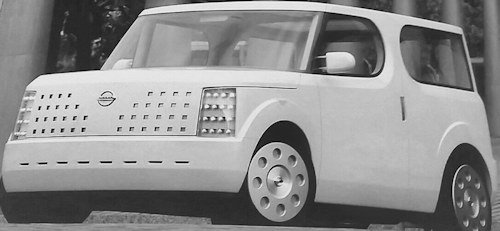Nissan Motor Co., Ltd. History
Yokohama, Japan

Nissan Motor Co., Ltd. (日 産 自動 車 株式会社 ) is a Japanese automaker, With previous Datsun and Prince brand company names.
History
The history of the company Nissan begins in 1911 with the founding of Kaishinsha Motorcar Works in Tokyo by Masujirō Hashimoto, who built his first passenger car in 1914. This was named the "DAT" after the initials of the investors' surnames Kenjiro D en, Rokuro A oyama and Aketaro T akeuchi, which enabled Hashimoto to build it. The company was later changed by 1918 to Kwaishinsha Motorcar Co. Because of the Japanese government laws to subsidize mainly trucks for the Imperial Japanese Army from the time. This later led by 1926 to the merger with the truck manufacturer Jitsuyō Motors and from this merger DAT Automobile Manufacturing Co., Ltd.
By 1930, the Datsun 10, a small passenger car with 495 cc capacity, brought to market, which closely resembled the Austin 7. The name Datson was based on English for "son of DAT", since DAT so far only produced luxury and larger vehicles. "Son" stands for "disadvantage" or "loss" in Japanese. In 1931, a hurricane destroyed the factory where the Datson 10 was assembled. After the factory renewal they decided to name rename in Datsun, where "sun" (English Sun) originates from the English and is an allusion to Japan as the land of the rising sun. The following Datsun 11 became the first name carrier of the company for passenger cars. In 1931, the automotive supplier Tobata Casting, which previously also supplied DAT, took over DAT Automobile Manufacturing Co., Ltd.

Parallel to this, 1928, the corporate holding Nihon Sangyō ( 日本 産業 ), whose shares were listed on the Japanese stock exchange under the acronym Nissan . Owner was Yoshisuke Aikawa, who also owned the company Tobata Casting. In March 1933, Tobata Casting acquired a large site in Yokohama, on which a car factory was to be built. Also, in 1933 there was a merger between Tobata Casting and Nihon Sangyō and on December 26, the company was under the company Jidosha Seizo Co., Ltd. What can literally be translated as "automobile manufacturers”. Datsun was to produce mass-produced vehicles in the future, while the high-end segment wanted to operate under a new brand name. In April 1935, the assembly line was complete and all vehicles were now in this production line. The work was then considered the largest and most modern of its kind in Japan. The first fully assembled Japanese car was built here, was the Datsun 14. After the parent company Nihon Sangyō became majority shareholder at the shareholders' meeting in June 1934, the company received its present name Nissan Motor Co., Ltd.
The economy of Japan was set for war in the 1930s. In May 1936, the Japanese government issued a law to protect the local economy. It stipulated that all car manufacturers with a production of more than 3000 units per year needed a license from the government. This affected only the factories of Ford and General Motors, which until then were market leaders in Japan. In 1937, import tariffs were drastically increased, thus eliminating American competition. With the outbreak of the Second Japanese-Chinese War in 1937, the demand for commercial vehicles continued to rise; Therefore, Nissan continued to produce mostly civilian vehicles and also trucks Buses. In addition to the production facilities, licenses for the replica of the Graham Paige truck and the Graham-Paige Crusader were also acquired in the USA at that time. According to the plans of the US manufacturer began in 1937, the production of the truck Nissan 80 and the top-of-the-range model Nissan 70 in Yokohama as the first vehicles under the brand name Nissan. In addition to the licenses of Graham-Paige Nissan also manufactured commercial vehicles to plans by Krupp. Licensed replicas of the Crossley armoured cars, aircraft and marine engines for the Japanese military was now built and in 1943 the manufacture of vehicles finally ceased completely.
After the War the main plant in Yokohama, had been damaged during the war. At the end of 1945, the first commercial vehicles rolled off the assembly line again; they accounted for most of the vehicles manufactured by Nissan for a long time and were needed to repair the war. In 1946, the company's headquarters were moved back to Yokohama. From 1947, the previously banned production of passenger cars was allowed in very small quantities. Two years later, the company renamed back again to Nissan Motor Co., Ltd.

After the outbreak of the Korean War in 1950 Nissan was able to win the US Army as a customer for a major contract and manufactured thousands of trucks for American licenses. The revenue from this contract benefited the production facilities, where old and obsolete machines were replaced by modern versions. The production of passenger cars also benefited from this acquisition, which was reflected by an increase in product quality. In the same year Nissan took over the company Minsei Diesel Motor Co., Ltd. whose company joined Nissan Diesel Motor Co., Ltd. ten years later. Since 1951, Nissan has worked in production with the company Shin Nikkoku Kogyo (now Nissan Shatai), in which initially the Nissan Patrol and light commercial vehicles were manufactured.
Like many other Japanese manufacturers, Nissan was looking for a license partner to catch up with the technological backlog of car production in other industrial nations. The British Austin Motor Company was won as a partner whose vehicles had already proven on the bad roads of Japan. In the 1950s, it officially came to work with Austin and thus later with BMC. In December 1952, a license agreement was concluded and the year after production began. Initially, the model A40 Somerset was partially dismantled shipped from England to Japan, assembled there and sold as Austin. Two years after the signing of the license agreement was on the model A50 Cambridge in accordance with the terms and conditions of the contract, Nissan began to gradually produce parts of the vehicle in Japan, until finally no deliveries from England were necessary. Thus, these cars were recently completely manufactured in Japan and there was a total of 21,859 manufactured by Nissan Austin’s before the license agreement expired in March 1960. In addition to the license production, however, own cars were still created and the right to patents of the British manufacturer also flowed into the Datsun product line.

Soon Nissan tried to open up new market segments and expanded the offer in 1957 to forklift (Nissan Forklift). In the 1960s, Nissan established branches in many countries around the world, including 1960s in the US, where automobiles have been exported for two years. In 1962, the first deliveries reached Europe and four years later, the first branch was established in Australia. In 1965, Nissan acquired the company Aichi Machine Industry Co., Ltd. based in Nagoya, a manufacturer of micro-cars with engines under 360 cc under the brand name Cony. In the same year, the production facilities in Yokosuka and Zama completed by a third plant formerly owned by the Prince Motor Company. This luxury car manufacturer was fully acquired in August 1966 and some of its vehicles, such as the Prince Skyline or the Prince Gloria, were gradually added to the Nissan model range. In 1966, Nissan launched in the course of expansion, a vehicle production in Mexico and thus owned the then first automobile factory in North America in Japanese possession. [8] The company headquarters was relocated in January 1968 again from Yokohama to Tokyo and should remain for more than 40 years there.

Another milestone in 1969 was the introduction of the first sports car of the Z-series, the Datsun 240Z. This vehicle brought Nissan worldwide a tremendous success, as it was offered at a low price. In 1970, the company pushed into other fields of activity. So was the production of boat engines started (Nissan Marine) and equipped with a Nissan engine rocket fired the first Japanese satellite Ōsumi into orbit. The vehicle industry was shaken by two oil crises in the 1970s, but the small and fuel-efficient Datsun models helped Nissan survive on the global market.
To put the company in a new light 1981 was announced that the brand name Datsun should be given up in favour of the name Nissan. The name Datsun served mainly as an export name after the Second World War. The Japanese management assumed that the American occupation forces Nissan would be remembered as an arms company and it was feared that cars under this name could not be sold abroad. But now, well over three decades after the end of the war, this was no longer considered problematic and the brand name was to be changed as part of a worldwide marketing campaign. But this also served to reduce the cost of advertising, since the company would then only known under a name.
In response to the luxury brands of Toyota (Lexus) and Honda (Acura) Nissan introduced in 1989 in North America, the new brand Infiniti. First came the Infiniti Q45on the basis of the Nissan President and later the Infiniti M30 (identical to the Nissan Leopard). In the same year, Nissan set up a European headquarters in the Netherlands to manage the local market.
I Nissan's financial position and fiscal year 1991/92 was the last year for a long time in which the group was able to make a profit. Nevertheless, when a recovery started a few years later, the company continued to lose billions of dollars in losses and sales volumes were also down. Therefore, Nissan was looking for a partner for cooperation and after Ford and Daimler had lost interest, they finally found it in the French manufacturer Renault, who himself had overcome a major crisis in the mid-1980s.On March 27, 1999, Renault and Nissan signed a contract that resulted in the Renault-Nissan partnership. The companies, which were linked by a share swap, continued to be independent, thus retaining control over their management and generating their own profits. Volvo Truck AB took over the majority shares in Nissan Diesel in 2006. From the beginning of 2007, the Group's own Volvo Truck Centre will take over the sales and service of Nissan Commercial Vehicles (Interstar, Cabstar, Atleon).
In 2007 it was announced that Nissan wants to start a joint venture together with the electronics group NEC in 2008. Together, the two companies want to develop car batteries for hybrid cars. In 2009, the company introduced the Nissan Leaf, a five-seat electric car, and announced it will launch in 2010 in Japan and the US. Since August 2, 2009, the head office of Nissan Motor Co., Ltd. is located. After more than 40 years back in Yokohama.
The strongest earthquake in Japan, the Tōhoku earthquake on March 11, 2011, also had a major impact on the activities of the Nissan Group. The major works Iwaki , Tochigi , Yokohama and Oppama ( Yokosuka ) as well as a business management facility in Zama and the Honmoku dock in Yokohama were damaged and had to cease operations immediately. Workers at facilities near the coast were evacuated for tsunami warnings. On Monday, March 14, and the Kyushu plant was established in Kanda closed and therefore all Nissan car factories had ceased production in Japan. On March 21, ran in all production facilities, the production of spare parts and parts for overseas production again, was exempt from the work Iwaki, was still working in the in the restoration of operability. Thus, the Nissan Group has overcome the natural disaster faster than the other Japanese automakers.
In April 2016, Mitsubishi Motors, Japan's sixth-largest automaker, announced manipulation of the fuel consumption of its models. 625,000 cars, including 468,000 copies of two models for Nissan, are affected.
Brands
Nissan: Nissan's volume models are sold worldwide under the Nissan brand.
Datsun: Until 1983, Nissan vehicles were sold in most export markets under the Datsun brand. In 1984, the Datsun brand was discontinued and replaced by the brand "Nissan". In 1984, all vehicles carried both the Datsun and the Nissan signet. In 1985, the name Datsun was completely gone. Datsun was reintroduced in 2013.
Infiniti: Since 1989, Nissan has been selling its premium vehicles under the Infiniti brand. In 2012 Infiniti moved its headquarters to Hong Kong, where it operates as Infiniti Global Limited. Chairman of the Board is the former head of Audi of America, Johan de Nysschen . From 2014, Infiniti vehicles will also be sold in Japan.
NISMO: Nissan's factory tuner is NISMO , short for "Nissan Motorsport International Limited."




